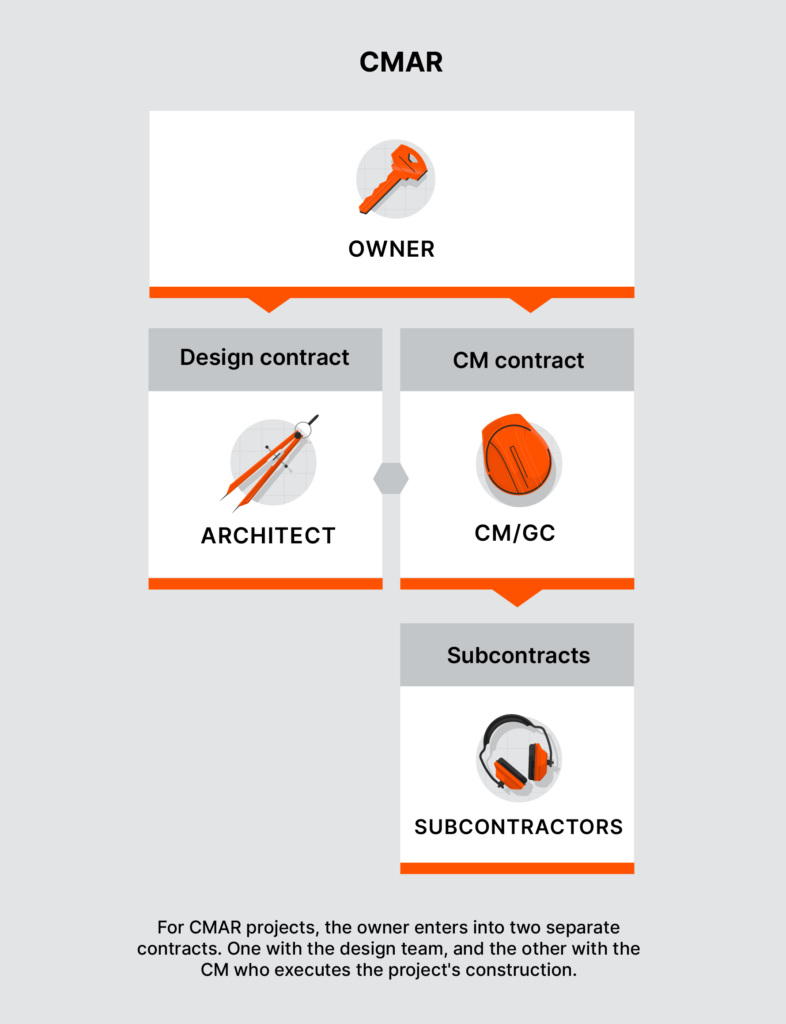— 9 min read
Construction Manager at Risk (CMAR) Pros & Cons
Last Updated Jun 25, 2024
Alex Six
Solution Specialist, C&I Industry Specialist
16 articles
Alex Six is an Enterprise & Strategic Civil & Infrastructure Overlay Account Executive for Procore. Alex has a long background in the construction industry beginning with an internship with one of the biggest contractors in the world, and expanding across projects with teams as small as 4 people and as large as multi-billion dollar budgets with large teams and disciplines. His resume includes Caltrans highways & bridges, Metro light rail & underground, as well as airport runways and utilities.
Kristen Frisa
Contributing Writer
110 articles
Kristen Frisa is a contributing writer for Procore. She also contributes to a variety of industry publications as a freelance writer focused on finance and construction technology. Kristen holds a Bachelor of Arts in Philosophy and History from Western University, with a post-graduate certificate in journalism from Sheridan College. She lives in Ontario, Canada.
Last Updated Jun 25, 2024

Construction manager at risk (CMAR) is a method of project delivery in which the owner contracts a construction manager during the design phase and oversee the project from buyout through closeout.
This method is increasingly preferred by owners because the CMAR contract shifts much of the risk and responsibility involved in the construction project over to the construction manager or CM firm. This delivery method is often referred to as "CM/GC" because the construction manager acts as both the construction manager (CM) and general contractor (GC) roles on the project.
CMAR contracts are generally used by owners who prefer to be involved throughout the building process and feel confident that they can find a construction manager that possesses the skills and experience necessary for a successful project outcome.
In this article we’ll take a deeper look at CMAR, exploring the full process of the delivery method and advantages and challenges it presents when implemented on construction projects.
Learn more: Project Delivery Methods Compared
Table of contents
The CMAR Process
On CMAR projects, the owner hires designers and builders under separate but overlapping contracts. Contractors and architects don't interact under this model, but work through the owner to create an optimal project design.
The owner first enters into a contract with an architecture and engineering firm to get started on the design phase of a project. Once the design is well underway, the owner enters into a separate contract with the construction manager (CM). The CM consults with the owner on the design to ensure it's as efficient and realistic as possible.

Once the design is complete, the owner will put the project out for bid, and construction managers will compete to take on the build's management and construction. In many cases, the owner will hire the CM involved in design to complete the remainder of the project. CMAR contracts are also favorable because they offer “open-book” bids, which foster transparency and provide for cost-savings for owners, while also driving competitive and complete bids for GCs leading to less change orders.
Once construction is complete, the CM will review the project with the owner and, finally, hand the project over to the owner.
The Benefits of CMAR for Owners
Owners using the CMAR construction project delivery model may realize several benefits compared with other models, including DB and DBB. While the method is increasingly popular among owners and builders alike, this organizational structure also has its downsides.
Transferred risk
The name CMAR says it all about this project delivery method – the construction manager on a CMAR build takes on the bulk of the risk for the project by providing the owner with a guaranteed maximum price (GMP).
Risk on construction projects could come from many aspects of the build – anything that could cost more money or take more time than initially planned poses a threat to the financial viability of a project.
For example, a municipal government could change compliance laws when a project has progressed well into its construction phase. To maintain compliance on the finished build, the contractor would have to go back and change the plans, then adjust the final product to adapt to the new rules.
Any oversight or unforeseen circumstances could increase the cost of construction. With CMAR, the construction manager would cover the additional costs to complete the build, not the owner.
Cost certainty
Owners may benefit from cost savings through CMAR.
First, the GMP gives owners an upper limit to the price they will pay for project completion. The GMP saves owners from the constant worry of the cost of change orders, delays, or other factors that could increase project costs.
Second, since the contractor that takes on the building contractor is often the same one who consulted on the design phase, the owner benefits from that firm's intimate knowledge of the work about to commence. That deep understanding can lead to more accurate and competitive bids, thus saving the owner money on the project.
Collaboration with the CM
CMAR allows owners to capitalize on the expertise of a seasoned general contractor before they finalize project designs. The builder may have knowledge of some aspects of construction that an owner or a designer do not, and can help optimize the design before the bid goes out.
Further, GCs can help owners and designers recognize overall project risk by identifying project timelines or details that could cause delays or cost overruns and offering solutions to mitigate those risks.
By effectively engaging in value engineering, the contractor's input could lead to more accurate cost and schedule projections -- and more informed bids overall.
Higher-quality project outcomes
Increased collaboration can lead to greater efficiency and shorter timelines, and consultation with seasoned contractors can lead to an overall better quality build. Input from another professional can lead the entire team to consider more angles.
To benefit from all the benefits of the CMAR method, including top-quality projects, owners must hire construction managers with the knowledge, experience, organizational capabilities, and collaborative approach to make it all work.
Stay updated on what’s happening in construction.
Subscribe to Blueprint, Procore’s free construction newsletter, to get content from industry experts delivered straight to your inbox.

Challenges of CMAR for Owners
CMAR is not necessarily the right project delivery method for every project. Some owners may
Time Consumption
Although schedules can be somewhat compressed because of early collaboration with the construction manager, the CMAR method may not allow for quick project turnaround as other methods like design-build.
With the owner positioned in the middle of the two stakeholders, constant back and forth communication through the owner can easily become a time suck. Using the DB method, designers and contractors are a single unit and can hammer out the design without owner input.
Cutting Corners
There is a potential downside to the cost certainty advantage for owners. When a GC gives a GMP, they might cut corners to save money. The owner is at risk of losing money because they may not be able to recoup losses if project costs exceeds the budget.
The Vetting Process
The construction manager on a CMAR project bears a great deal of responsibility for the outcome of the project. An inexperienced manager could cause problems in both the design and construction portions of the project, leading to fundamental problems with the product quality, disputes between stakeholders, and ultimate project failure.
Owners should seek out construction managers who have extensive experience on similar projects, and have a reputation for both competence and communication.
Advantages of CMAR for Construction Managers
The CMAR project delivery method offers contractors the benefit of early input on construction design and favorable bidding odds.
Influence on Construction Design
The challenge with other project delivery methods is that the contractor is not involved in the design process, but is liable to complete the construction project as designed. Any changes need to go through a change order process.
CMAR allows the CM to gain intimate knowledge of and influence over the entire project and its design before it ever goes to bid, which can increase confidence in bidding and success during the construction process.
Improved Bidding
After the project design is complete, owners open the bid for its construction. While there is every possibility that another general contractor will win the bid, the owner will often award the project contract to the CM involved in the design.
During the design phase, the CM that comes in to consult becomes very familiar with the project and the owner's goals. Other bidders may only get a few months to develop bids, while the consulting CM has been deeply involved for much longer.
That knowledge is apt to give the CM the edge in developing an efficient and innovative bid for project construction. The CM is less likely to over or under-bid thanks to some oversight and can be more confident in the bid price.
This confidence is a double-edged sword – the CM will likely provide a GMP to an owner within the contract documents, and the GMP must be competitive for the CM to win the bid. Any errors or unexpected developments can impact the CM's profit margin.
Challenges for CMs
Construction managers can benefit significantly from the CMAR construction delivery method, but they must do due diligence to mitigate risks.
Increased Risk
With all of this influence comes great responsibility for the CM/GC. Any failures that arise during the project may fall to the CM/CG to rectify. Added costs and time delays due to natural disasters or unexpected site conditions would be the construction manager’s responsibility. Poorly defined or inaccurate scope could also eat into the CM/GC’s profits on a project.
Contract documents should spell out project scope as clearly as possible and lay out contingencies to protect the construction manager against undue risk.
Damaged Reputation
Shouldering the bulk of managing duties and risk can tarnish a construction manager’s reputation if events on a project consistently go awry. This could pose challenges to find future work for CM/GCs if they are unable to successfully execute their projects.
5 Ways to Improve the CMAR Process
To reap the benefits of CMAR project delivery, owners, designers, and construction managers all need to understand and fulfill their roles, successfully work with other stakeholders, and use the full extent of their knowledge and experience.
Below are five key ways project leaders can ensure project success.
1. Contract Clarity
The construction contract should be clear about roles and responsibilities, project scope, the risk each stakeholder assumes, payment terms, communication guidelines, and protocols for resolving disputes. Make sure all stakeholders read and understand the contracts they sign.
2. Collaborate Early
Much of the benefit of using CMAR is the input the construction manager brings to the project. The CM should be engaged early in the design phase to achieve better constructability reviews, value engineering, and informed decision-making.
3. Streamline Communication
Better communication leads to cleaner construction. Clear communication protocols can help set expectations for what, when, and how stakeholders should exchange information. Regular meetings, progress reports, communications sent through organized project-specific channels, and open expression of concerns can avoid costly errors and disputes.
4. Open Books
The construction manager should maintain cost transparency with the owner, sharing information about estimates, subcontractor bids, materials, labor, and other expenses. Open books can allow the owner to add input that could improve project success and mitigate the risk of disagreements.
5. Simplify Change Order Processes
Change orders are often a source of delays, disputes, and increased costs. Establish a clear change order process that defines how the contractor should handle changes.
Was this article helpful?
Thank you for your submission.
100%
0%
You voted that this article was . Was this a mistake? If so, change your vote
Scroll less, learn more about construction.
Subscribe to The Blueprint, Procore’s construction newsletter, to get content from industry experts delivered straight to your inbox.
By clicking this button, you agree to our Privacy Notice and Terms of Service.
Thank you!
You’re signed up to receive The Blueprint newsletter from Procore. You can unsubscribe at any time.
Written by
Alex Six
Solution Specialist, C&I Industry Specialist | Procore Technologies
16 articles
Alex Six is an Enterprise & Strategic Civil & Infrastructure Overlay Account Executive for Procore. Alex has a long background in the construction industry beginning with an internship with one of the biggest contractors in the world, and expanding across projects with teams as small as 4 people and as large as multi-billion dollar budgets with large teams and disciplines. His resume includes Caltrans highways & bridges, Metro light rail & underground, as well as airport runways and utilities.
View profileKristen Frisa
Contributing Writer | Procore
110 articles
Kristen Frisa is a contributing writer for Procore. She also contributes to a variety of industry publications as a freelance writer focused on finance and construction technology. Kristen holds a Bachelor of Arts in Philosophy and History from Western University, with a post-graduate certificate in journalism from Sheridan College. She lives in Ontario, Canada.
View profileExplore more helpful resources

Using Standard Operating Procedures for Better Contract Management
Every construction project is different, meaning that GCs have to be continually agile and strategic about applying their experience. Major categories change from project to project, from the owner to...

Understanding Supplementary Conditions on Construction Contracts
No two construction projects are exactly alike — and the same goes for construction contracts. Even when using a standard contract form, owners and contractors sometimes use supplementary conditions to...

A Straightforward Guide to Construction Contract Review
Construction contracts are like the glue for the project team. They’re the ties that bind the working relationships and goals for the project, containing information about responsibilities, liabilities and processes...

Escalation Clauses in Construction Contracts: When and How They Apply
In construction contracts, an escalation clause allows for the escalation of a certain price for labor or materials to be used in a construction project. This type of clause is most...
Free Tools
Calculators
Use our calculators to estimate the cost of construction materials for your next project.
Templates
Find a template to help you with your construction project tasks.
Material Price Tracker
Get the latest U.S. retail prices and view historical trends for common building materials.
Glossary
Explore key terms and phrases used in the industry.
